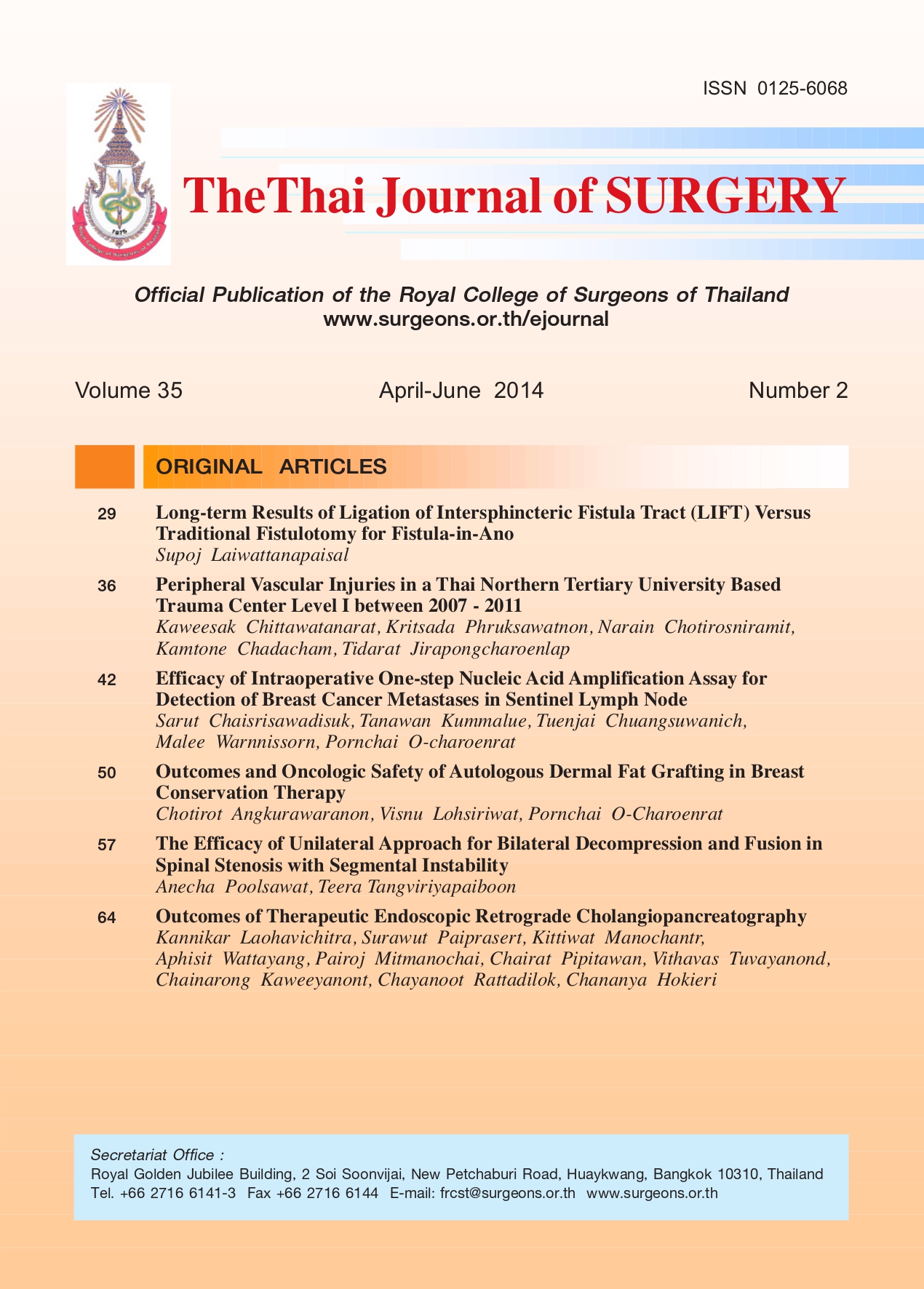The Efficacy of Unilateral Approach for Bilateral Decompression and Fusion in Spinal Stenosis with Segmental Instability
Keywords:
Transpedicular screw fixation, transforaminal lumbar interbody fusion, unilateral Approach for Bilateral Decompression & Fusion (UBD & Fusion)Abstract
Objective: To evaluate the efficacy of the unilateral approach for bilateral decompression and fusion (UBD &fusion) in spinal stenosis with segmental instability
Methods: Retrospective review of patients underwent surgery with unilateral approach for bilateral decompression
and fusion during April 2010 and April 2012 was performed. Fifty one patients were included in the study. The visual
analog scale (VAS), Neurogenic Claudication Outcome score (NCS), and Prolo Functional and Economic Scales (Prolo
score) were used to evaluate all patients preoperatively and at 1-year follow-up. The success of the intervetebral fusion
was assessed at 1 year after index surgery. Complications, including adjacent segmental degeneration and instrument
failure, were recorded in the postoperative assessment.
Results: Fifty one patients who underwent unilateral approach for bilateral decompression and fusion achieved
favorable outcome. The VAS, NCS and Prolo score had significantly improved at 1- year follow-up and the fusion rate
was 100 percent with no surgical complication.
Conclusions: Favorable results from the novel technique “Unilateral Approach for Bilateral Decompression and
Fusion” were found. This technique gives an adequate bilateral nerve roots decompression with high successful spinal
fusion rate.
References
transvertebral interbody cage with posterior transdiscal
pedicle screw instrumentation for high-grade spondylosthesis.
Neurosurg Focus 2006; 20(3): E7.
2. Beringer WF, Mobasser JP. Unilateral pedicle screw
instrumentation for minimally invasive transforaminal lumbar
interbody fusion. Neurosurg Focus 2006; 20(3): E4.
3. Cole CD, McCall TD, Schmidt MH, Dailey AT. Comparison of
low back fusion techniques: transforaminal lumbar interbody
fusion (TLIF) or posterior lumbar interbody fusion (PLIF)
approaches. Musculoskelet Med 2009;2:118-26.
4. Dipierro , et al. Treatment of lumbar spinal stenosis by extensive
unilateral decompression and contralateral autologous bone
fusion: operative technique and results. J Neurosurg 1996;
84:166-73.
5. Houten JK, Post NH, Dryer JW, Errico TJ. Clinical and
radiographically/ neuroimaging documented outcome in
transforaminal lumbar interbody fusion. Neurosurg Focus
2006;20(3): E8.
6. Jane JA, diPierro CG, Helm GA, Shaffrey CI, Jane JA. Acquired
lumbar stenosis: topic review and a case series. Neurosurg
Focus 1997;3(2):Article 6.
7. LIU, et al. Protective effects of preserving the posterior complex
on the development of adjacent-segment degeneration
afrer lumbar fusion. J Neurosurg Spine 2013;19:201-6.
8. Morgalla MH, Noak N, Merkle M, Tatagiba MS. Lumbar spinal
stenosis in elderly patients: is a unilateral microsugical approach
sufficient for decompression? J Neurosurg Spine 2011;14:305-
12.
9. Musluman, et al. Midterm outcome after a microsugical
unilateral approach for bilateral decompression of lumbar
degenerative spondylolisthesis. J Neurosurg Spine 2012;16:
68-76.
10. Rengachary SS, Balabhandra R. Reduction of spondylolisthesis:
Neurosurg Focus 2002;13(1):Artticle 2.
11. Rosa GL, Cacciola F, Conti A, Cardali S, Torre DL, Gambadauro NM, Tomasello F. Posterior fusion compared with posterior
interbody fusion in segmental spinal fixation for adult
spondylolisthesis. Neurosurg Focus 2001;10(4):Article 9.
12. Salerni AA. A minimally invasive approach for posterior lumbar
interbody fusion. Neurosurg Focus 2002; 13(6).
13. Sasai K, Umeda M, Maruyama T, Wakarayashie E, Iida H.
Microsurgical bilateral decompression via a unilateral
approach for lumbar spinal canal stenosis including
degenerative spondlolisthesis. J Neurosurg Spine 2008;9:
554-9.
14. Schnee CL, Freese A, Ansell LV. Outcome analysis for adults
with spondylolisthesis treated with posterolateral fusion and
transpedicular screw fixation. J Neurosurg 1997;86:56-63.
15. Tangviriyapaiboon T. Mini-open transforaminal lumbar
interbody fusion. J Med Assoc Thai 2008;91(9).
16. Winn HR, YOUMANS. Neurological surgery, sixth edition,
Chapter 291 Basic Principles of Spinal Internal Fixation and
Chapter 292 Bone Graft Options, Bone Graft Substitutes, and
Bone Harvest Techniques p.2979-2998
17. Wong HK, Goh JC, Goh PS. Paired cylindrical interbody cage
fit and facetectomy in posterior lumbar interbody fusion in an
asian population: SPINE 2001; 26(5), 572-7.
18. Xu et al. Biomechanical Comparison of Posterior Lumbar
Interbody Fusion and Transforaminal Lumbar Interbody Fusion
by Finite Element Analysis. Neurosurgery 2013;72[ONS Suppl
1]: ons21-ons26.
Downloads
Published
How to Cite
Issue
Section
License
Articles must be contributed solely to The Thai Journal of Surgery and when published become the property of the Royal College of Surgeons of Thailand. The Royal College of Surgeons of Thailand reserves copyright on all published materials and such materials may not be reproduced in any form without the written permission.



